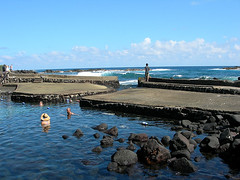 Image by emilychang via Flickr
Image by emilychang via Flickr
Situated just South of Sarasota, Florida, a cultural resource with tremendous historical and cultural value, Warm Mineral Springs has a history that extends back more than 10,000 years. Archeological finds at the site have demonstrated its importance to the Aborigines populating what is now Florida that far back, or longer. In the Colonial period of European history, legend has it that the Spring was a sought after site by explorers to include Ponce De Leon. There is significant evidence that suggests that this was indeed the legendary Fountain of Youth that Ponce De Leon was seeking when he was mortally wounded just a few miles from the site in a battle with the Calusa Indians. As early as the 1930’s, the site was a popular modern tourist attraction with tourists to include a United States president seeking out the famed healing waters of the Spring for bathing. Indeed fossils including a number of Paleo-Indian remains indicate that the spring has been attracting human interest for well over 10,000 years. Over the last 500 years, the site has been the focus of much conflict and political intrigue. Ponce De Leon lost his life trying to find it and in the twentieth century a number of controversial activities such as using the Spring as a dumping site and controversial management of the cultural artifacts have been constant in the Springs history. ControversyCol Royal's Discoveries rewrote North American history but his methods were controversial at best grew to a fevered pitch in the late 1950's when retired Air Force Colonel William Royal recovered human remains from the site that he dated at 10,000 plus years old. The academic community continued to skoff at Royal's claim until the 1970's when the Archeologist for the State of Florida located additional skeletal material from the site that were also dated to the same era. Today, the Spring’s new owners want to turn over a new leaf in the management and preservation of this valuable resource for Southwest Florida.
Plans have been underway now for some time to obtain a realistic look at what lies below the water’s surfaces, and what steps need to be taken to preserve both the ecological and archeological assets that lie there. They also desire to educate the public about this valuable resource and its history. To accomplish this goal will require countless hours of dive time, historical research, and analysis. Every journey begins with a first step and the first real steps in decades were taken on September 18, 2010, when a team of ten volunteer divers made their first orientation dives into the site. Ultimately, this team will help to restore and preserve the assets that lie below. The research into this site has been abandoned for more than 20 years when the last academic projects pulled out in the midst of controversy and continuing intrigue. Since that time, just a few exceptions the Spring’s waters have only been open to the swimmers and waders that inhabit the top few feet of the 76m deep spring.
The Spring is one of the very few salt water thermal springs in North America. The deep-water vents enter into the basin at around 76 m / 250 ft bringing mineral laden salt water with a temperature of around 98º f / 37ºc. These waters are believed to come from at least 3,000 feet below the surface and some of the research completed at the Spring seems to validate that the waters contain healing properties. The same properties that led Ponce De Leon to label the Spring, “The Fountain of Youth”, as legend has it. The Spring basin also has some fresh water vents flowing much cooler water and which when blended with the hot water lowers the Spring’s temperature to a comfortable 87 º F / 31ºc, providing a pleasant warm water swimming experience for the thousands of tourists that flock here every year. The warm water also contains no dissolved oxygen below a depth of about 15 feet /5 meters, which explains the spring’s unique ability to preserve ancient artifacts. To date the site has revealed the remains of North American camels, giant sloths, saber tooth cats, a number of humans and a variety of pre-historic plants.
Thanks to Seaduction and Mike Angie
Kathy Dowsett
www.kirkscubagear.com

I see a movie in the making!
ReplyDelete